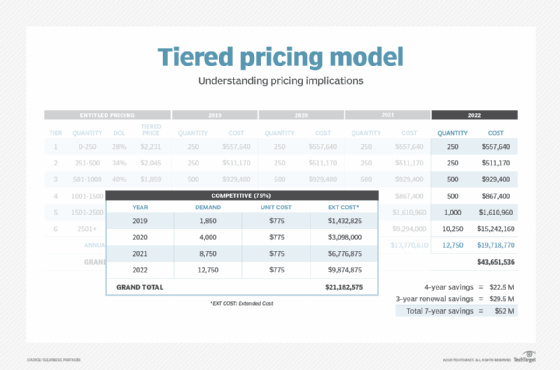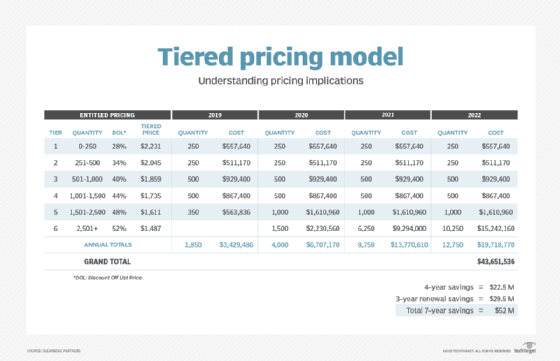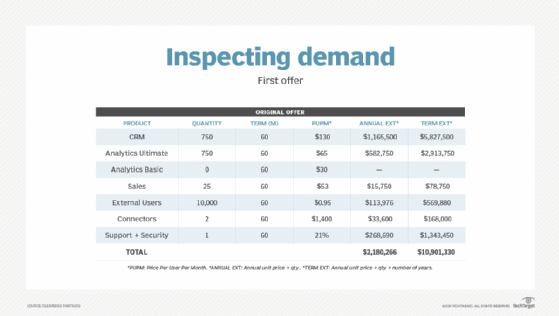How to negotiate a good software subscription agreement
A big mistake IT execs make in negotiating software subscription deals is overbuying. Here are seven steps from ClearEdge Partners' Rachel Annello that will lead to a better deal.
Negotiating a software subscription agreement with a major vendor is a challenge for even the most sophisticated IT organizations. Software subscription agreements are often complex and confusing, and few CIOs have the resources or time to decode, much less drive, the negotiating process. The result is that IT organizations can be outmaneuvered by professional sales teams, settling for the vendor's deal rather than one that meets their company's needs and budget, according to consulting firm ClearEdge Partners.
"One of the biggest issues we see when our customers are purchasing subscriptions is overbuying," said Rachel Annello, a senior analyst at ClearEdge. "The reason overbuying is such a huge problem is because oftentimes there are clauses in these agreements that prevent you from downturning licenses at the end of the term." And even if you can reduce your license count, you might end up paying more, Annello said. That's because a decrease in licenses could nullify the renewal price cap you negotiated and replace it with list price.
Another misstep: Disclosing too much information. Buyers often make the mistake of putting "wish list" items on the table too soon, thereby signaling a deal size their sales reps will be loath to give up if those items don't make it into the final deal. "Your sales rep sees a commission number and is excited about it. So, as that goes down, they will want to increase the prices of the remaining line items," Annello said.
ClearEdge works with clients throughout the deal cycle to increase leverage and control costs. In a recent webinar, "Building Growth into Subscription Agreements," Annello focused on a critical stage in forging a good software subscription deal: forecasting and modeling.
She laid out a checklist of seven steps that will help CIOs and their teams level the playing field and explained how these steps can drive value in various subscription deal models.
How to prevent overbuying in software subscription agreements
 Rachel Annello
Rachel Annello
Here are the first three steps for negotiating a good software subscription agreement. Completing them requires that CIOs and their IT teams have a clear understanding of what projects are in the pipeline and of their organization's capacity to implement and adopt the technology they are purchasing.
1. Build your demand model. "It's really important to do this yourself and not let the supplier do it for you," Annello said. Ideally, an IT organization would create its software-subscription demand model from scratch, figuring out which products are needed without any help from the supplier. Most organizations find this "very difficult" to do, so they turn to the vendor to help them figure out the scope, she added. But its quote is usually inflated and should be considered a starting point.
2. Reduce demand projections as needed. "The supplier's goal is to put as much into the agreement as possible," Annello said. Rather than taking the vendor's demand model at face value, CIOs and their teams must validate the projections before moving ahead with negotiations. "You need to go in and look at how much you actually need for your business and the projects you're running -- and reduce the demand projections where necessary."
3. Slow the deployment schedule. Sales reps will typically present a "buy upfront model" that groups purchase at the start of subscription agreements. CIOs need to analyze the line items through the lens of what the business and its IT organization have planned and can accomplish.
"What you need to do," Annello said, "is go in and ask, 'When are these projects actually rolling out? How long is adoption going to take? What's our implementation look like?'" The due diligence will invariably show that the Deployment schedule provided by the sales rep is overly aggressive, she added.
Getting to win-win
Steps four through seven focus on taking control of the negotiations and incentivizing your sales rep to offer you the best deal.
4. Take control of the negotiations. Having completed the first three tasks, the next step is to send your demand model to the sales rep. "Building your demand model, lowering demand projections and slowing the deployment schedule takes dollars out of the agreement, and it lowers your starting point for negotiations, which thereby allows you to take control," Annello said.
However, it's critical to send your revised demand model to the rep early in the negotiations, she added. Sending a demand model that removes $2 million from a $5 million deal at the last minute -- to a sales rep who has essentially already banked the deal -- doesn't work because the rep likely will respond by hiking product prices. "When we see our customers do it late, what happens is the suppliers just go in and increase your unit rates of existing licenses to make up for the lost revenue."
Even as you take steps to control the negotiations, Annello said it is important to create the proverbial win-win scenario. "That means you feel like you got what you needed out of the negotiations, but the supplier also feels like they won as well," she said, which leads to the next must-do -- a year-one purchase commitment.
5. Make a year-one commitment. Sales reps typically make their commission off net new revenue in year one of the subscription agreement. "If you don't make that year-one commitment, your sales rep is not nearly as incentivized to get you to sign the deal," Annello said. A motivated sales rep, on the other hand, will look for ways to close the deal. "When your sales rep feels incentivized, that's when they lower your rates to get you to sign."
6. Create deal options. CIOs and their IT teams should create deal options around the year-one commitment they've made, including a smaller year-one commitment that contains only what their organization really needs now and a larger deal which includes desired items. The strategy is to signal to the sales rep that you are willing to go either way.
"The sales rep is going to push you toward that largest option" with the bigger commission, Annello said. "So, what you want to do is create this really great option that has a lot of wish list items in there. Best case scenario, you get this great deal for a great price."
7. Message your risk in the demand model. Here, you are essentially using risk as leverage to get a better deal. Your risk may be the uncertainty that organization will adopt everything listed in the deal, or that your C-suite is not convinced of the need for the scope of services or products. An effective "risk message," according to Annello, lets the vendor know you're willing to go with any of the deal options on the table -- provided the vendor can lower your risk. "The way that sales reps typically incentivize you is by reducing the risk, and a common way of reducing the risk is lowering the cost of the deal," she said.
Focusing on risk: Be conservative
Because the risk message can be an effective bargaining chip, CIOs and their teams need to get it right. "The most important thing is to be conservative," Annello said. ClearEdge asks clients to determine a "confidence level" of high, medium or low for each line item in the agreement -- and modify the demand model accordingly.
- "For 'low confidence' [items], we can either remove that line item altogether, or we can significantly slow the deployment schedule," she said. In a three-year agreement, that may mean scheduling the rollout of the product in year three; in a five-year agreement, the deployment could be pushed to year four or year five, she said.
- For items labeled "medium confidence," IT organizations should go with their minimum quantity projections and likewise slow the deployment schedule.
- A "high confidence" line item is left in the demand model, but it's still critical to verify the deployment schedule, Annello said. "The reason it's so important to ensure it is accurate is because it's very difficult to take things out of the agreement late [in the negotiations]. You can always add things back in -- so, again, when in doubt, be conservative."
In the second half of the webinar, Annello analyzed how ClearEdge's seven-point checklist can be applied to different kinds of software subscription agreements. Here, we review her analysis of two demand models: tiered pricing and ramp models.
Tiered model: What is it and what are the pitfalls?
Tiered pricing is essentially a volume-based pricing model: As the deal amount increases, the price of the items decreases. ClearEdge clients typically do not use this model for negotiating their deals, Annello said, but it is deployed often enough that CIOs must understand where this approach falls short -- and how it flouts ClearEdge's seven-point checklist detailed above. To illustrate, Annello went through the tiered price tables created for two customers buying Red Hat products (pictured).

Customer A's table, a large deal for Red Hat products in general, is organized by the dollar range for items purchased in each year of the deal and the discount off list price.
The deal starts at less than $1.5 million in the first year and goes up to $9 million in year five. "As their list price spend goes up, their discount rate goes up as well," Annello said.
Customer B, in contrast, chooses a different metric: a tiered model based on the quantity of items rather than projected dollar ranges per year: The quantity range for the Red Hat OpenStack deal starts at 0 to 50 and goes up to over 601 items. Similar to customer A, as customer B's deal amount goes up, the discount rate also goes up, but the two models show some important differences.
The starting point for customer A is a 29% discount, whereas for customer B it is 48%. To compare the models, ClearEdge calculated a dollar amount for the quantities listed in customer B's model, applying the designated discount to the highest number of the items in each range. (Dollar amounts are shown in blue in the chart above.)
The upshot: Customer A is spending $2.5 million to get a 44% discount, whereas customer B is only spending $154,900 to get a 48% discount. At the top range of the deal, customer A must spend $9 million to get a 64% discount -- customer B only has to spend $1.9 million.
"Large deals can get really poor discounting and small deals can get really great discounting," she said. But either way, when you go to a vendor and ask for a tiered price model, "you're basically indicating [to the vendor] that you're OK with volume-based pricing" as the method to build growth into your software subscription agreement, she said. "We'd rather focus on bottom-line costs."
Tiered pricing model: Understanding pricing implications
To illustrate the importance of building a demand model and taking control of the negotiations, Annello presented the tiered pricing table (pictured) of customer C. This client agreed to a tiered pricing table before it knew its demand in order to avoid the hassle of negotiating during the course of the deal. "When they actually built out their demand model and had to use this pricing model, they brought us their quantities and asked us to model it out."
The grand total came to $43.7 million over four years of the agreement. "Part of the reason their cost is so high is because they're scaling up their quantity significantly," Annello said, from 1,850 licenses in 2019 to 12,750 in 2022.
"The first problem with the tiered table they signed is that it only goes to 2,500 licenses. If they had known they were scaling up to 12,750, they probably would have tried to capture more value and higher discount levels at the bottom of their tiered table," she said.
Annello said customer C also had language in the agreement stating it had to purchase all the licenses in the first year before it could get the price for the second tier and so on. Not only does this stipulation create different unit prices across the business, but it also blends the discounts for each of the four years: "Your blended discount comes out much lower than that 52% [offered in the final year of the deal]," she said.
Bottom-line mistake? A price tag that was much higher than it had to be. "Competitive pricing [for similar deals] would have put this table at $21.2 million over the term," she said, for a four-year savings of $22.5 million (pictured).

"The customer left a lot of money on the table, because they didn't build their demand model and they didn't understand the pricing implications of that," she said. "They were more worried about their unit rates and discounts than they were in the total budgetary costs."
Pitfalls of not following the seven-point checklist
By focusing on its unit rates and discounts, Annello said customer C also put limits on deals going forward: In ClearEdge's experience, renewal price in most software subscription agreements is based on the price in the last year of the agreement. "In this case, the customer is entitled to pricing that put them at $19.8 million in year four, while [competitive pricing] is $9.9 million, for a loss of about $29.5 million over the three-year renewal," Annello said.
"All in all, this customer over seven years left $52 million on the table by doing this tiered pricing agreement," she added.

To recap the mistakes that led to overbuying: Customer C did not build a demand model upfront, so it was not able to reduce demand projections or slow its deployment schedule. As a result, it failed to take control of the negotiations: When the company actually had to buy licenses, it had already signed the tiered table deal -- "and that's really hard to get out of," Annello said. "Now you're basically begging for better pricing instead of negotiating."
Customer C also did not make a year-one commitment, choosing instead to buy as it went; there also were no deal options on the table because "there were no negotiations," Annello said. Finally, customer C did not message the risk model, instead taking a pay-as-you-go model that did not convey any risk to the sales rep.
Ramp model: How to prevent overspending
While tiered pricing is portrayed as the "bad guy" in ClearEdge's guidance ("and it kind of is," Annello noted), it is also an effective way to hold down the price in an agreement you've negotiated well, she said. That includes deals structured using the so-called ramp model.
A demand model that scales up as rollout progresses, the ramp model is the easiest and least complex way to effectively build growth into a software subscription model, according to Annello.
As noted, most suppliers offer "buy upfront" models; the purpose of building a ramp model is to validate the scope of the deal, she said -- "and don't forget to be conservative when you're doing this."
To show how the ramp model works, Annello used an example of a customer doing a request for proposal with a leading CRM provider. The client asked the vendor what it thought the company needed to run its environment for the planned use case. The sales rep presented a five-year deal for $10.9 million (pictured). The buyer's question for ClearEdge: Was the rep's price a good deal?

The seven-point checklist was applied, with a list of tasks for the client, beginning with whether it needed the quantities listed in the vendor's table. In validating the vendor's model, the company found the figure was over-aggressive for its needs and capabilities and reduced the quantities, bringing the deal down from $10.9 million over five years to $8.7 million. Neither would the business be able to deploy everything in year one, so the company created a ramp model in which some deployments took place in year one but many more fell into year two. "That took another $1 million out of the deal," dropping it to $7.9 million (pictured), Annello said.

By building its own ramp model, the client was able to reduce the demand projections -- and then negotiate from a much lower starting number. The demand projections were conservative, but not so conservative that the client was going to run into license compliance issues down the road, Annello said. In addition, the client wanted to slow deployment -- but not too much. "If you slow it too far, then you don't have the licenses when you need them for that … rollout," she said.
The upshot is the customer took control of the negotiations, ultimately dropping the cost of the deal. However, it still made a year-one commitment, while pushing some of the initial purchases into year two. This particular customer did not have deal options "for simplicity's sake," said Annello, but she said that doesn't mean companies can't create deal options in a ramp model. The customer did message the risk, though, telling the vendor it might have adoption problems and was not sure of the timeline or whether the products would work for their business.
For Annello's advice on how to apply ClearEdge's forecast and modeling guidelines to capped enterprise license agreements (also called fixed quantity cap models) and unlimited license agreements, visit ClearEdge to access her webinar.
About ClearEdge Partners
Founded by senior sales executives from large IT suppliers and informed by current market analytics, ClearEdge enables CIOs and their teams to make more competitive IT investments. By combining rigorous inspection and IT financial expertise, they identify risk and opportunity, align internal teams and maintain leverage throughout the lifecycle of supplier relationships. As a result, their clients maximize the value of their investments by unlocking millions of dollars from legacy spending and redirecting funds toward IT modernization, digital and cloud transformation with confidence and speed.






